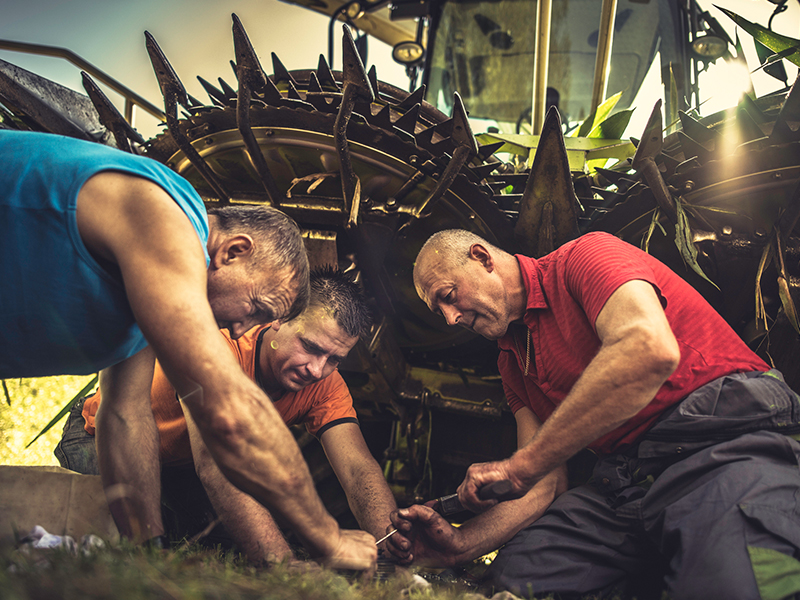Augers, choppers, drives … there are a multitude of ways to injure yourself when operating combine harvesters. Here the Queensland Government examines where the danger lies and gives some excellent harvester safety tips
 |
Planned maintenance and skilled equipment operation can curb downtime and reduce the potential for accidents during harvest.
Make sure you, your employees, relief drivers or contractors are properly trained in how to use the harvester safely.
Operators must be made are aware of the risks and the safe operating procedures and provided with an instruction manual. This should give instructions on safe use of the machinery, clearing blockages and the recommended procedure for cleaning the combine and grain tank between crops.
Harvester hazards
- Becoming entangled with the levelling or discharge augers in the grain tank
- Falling from the machine, especially during pre/post season cleaning
- Contacting overhead power lines
- Being run over
- Contact with the knife, reel or stripper rotor
- Contact with the straw chopper or spreader
- Being trapped under the header or injured by the header falling from its transport trailer
- Being injured by the drive mechanisms or trapped when automatic sensors operate
- Dust
- Fires
- Noise
What not to do
- Climb or reach into the grain tank unless the engine and all augers are stopped, and the ignition key has been removed
- Climb round areas of the combine unless there is purpose built access available (such as steps and standing areas)
- Carry passengers on the header unless a passenger seat is provided
- Let people jump on or off your harvester when it is moving
- Work under an unsupported header
- Carry out maintenance or try to adjust automatic sensors with the engine running
- Park, carry out maintenance or extend the unloading auger when under or near overhead power lines
- Run the combine with the guards raised or removed
- Allow children on or near the combine
- Brake harshly, especially on slopes
What to do
- Make sure anyone working on the harvester has read and understood the instruction book
- Carry out the ‘safe stop’ procedure before carrying out any maintenance
- Have a system for thorough pre-season maintenance checks to ensure that all brakes, guards and other safety devices are in effective working order
- Use any grain sampling mechanism provided
- Have a safe system of work for combining paddocks where there are overhead power lines. This may form part of your written safety policy, but should include as a minimum: knowing the height of your machine (at the highest point including aerials) and the height of overhead power lines. A warning sign as a visible reminder in a prominent position is a good idea.
- Use appropriate farm maps as reminders when daily work is being planned
- Agree upon routes for travel with the local electricity supply company which take into account safe clearance distances
- Follow correct procedures for working under the header (use the supports provided)
- Follow correct procedures when transferring the header on and off its transport trailer
- Provide and use correct tools and a knife guard to aid safe removal, handling and storage of the cutting knives
- Work with the cab door shut (helps control dust and noise)
- Be particularly careful when reversing – make sure you can see what is behind you. Sound the horn before starting the engine or reversing
- Wear slip resistant footwear and avoid wearing loose clothing
- Take care on steep ground and avoid sudden changes of direction. Brake and turn cautiously on downhill and side slopes
- Park across slopes if possible and ensure the handbrake is fully applied before leaving the vehicle
- Make sure all guards are in position and correctly fitted before starting work
- Regularly clean straw and chaff deposits from the engine compartment and around belts and pulleys
- Make sure there is suitable fire-fighting equipment (such as a fire extinguisher) available on the combine (and that the extinguisher is regularly checked)
General harvester safety
- Make sure all guards and shields are in place.
- Ensure all workers are trained in proper operating technique and safety procedures when using machinery.
- Stop all moving parts before servicing the machine.
- Operators should take regular breaks.
- Protective footwear and close-fitting clothes are essential when working in and around machinery.
- Use suitable access equipment and take precautions for work at height during cleaning and maintenance operations.
- Be patient when working in difficult crop conditions such as laid crops or unfamiliar fibrous crops like linseed.
- Don’t operate the machine beyond its capacity (that is, don’t overload it).
- Use your instruments and watch and listen for potential blockages – avoiding blockages is easier than clearing them.
- Use drive reversing mechanisms, when fitted, to wind out blockages.
- Remember the baler operator – try to avoid leaving heaps in the swath.
- Remember the hazards posed by straw choppers and spreaders – allow adequate rundown time before approaching the rear of the combine.
- Combines fitted with yield-measuring meters using an ionising radiation source need additional safety procedures which must be laid down, clearly understood and implemented. (There may be additional legal obligations when these devices are fitted.)
- Exposure to high levels of grain dust causes ill health, including occupational asthma, farmer’s lung, grain fever, chronic bronchitis, allergic eye and nasal infections. Close the cab door or use respiratory protective equipment.
- Make sure the cab filter is of the type recommended by the manufacturer and is fitted and maintained in accordance with the manufacturer’s instructions.
- When unloading on the move consider the other driver and avoid sudden manoeuvres.
More agriculture safety tips are available from the Queensland Government’s safety and compensation services website: www.worksafe.qld.gov.au/agriculture

